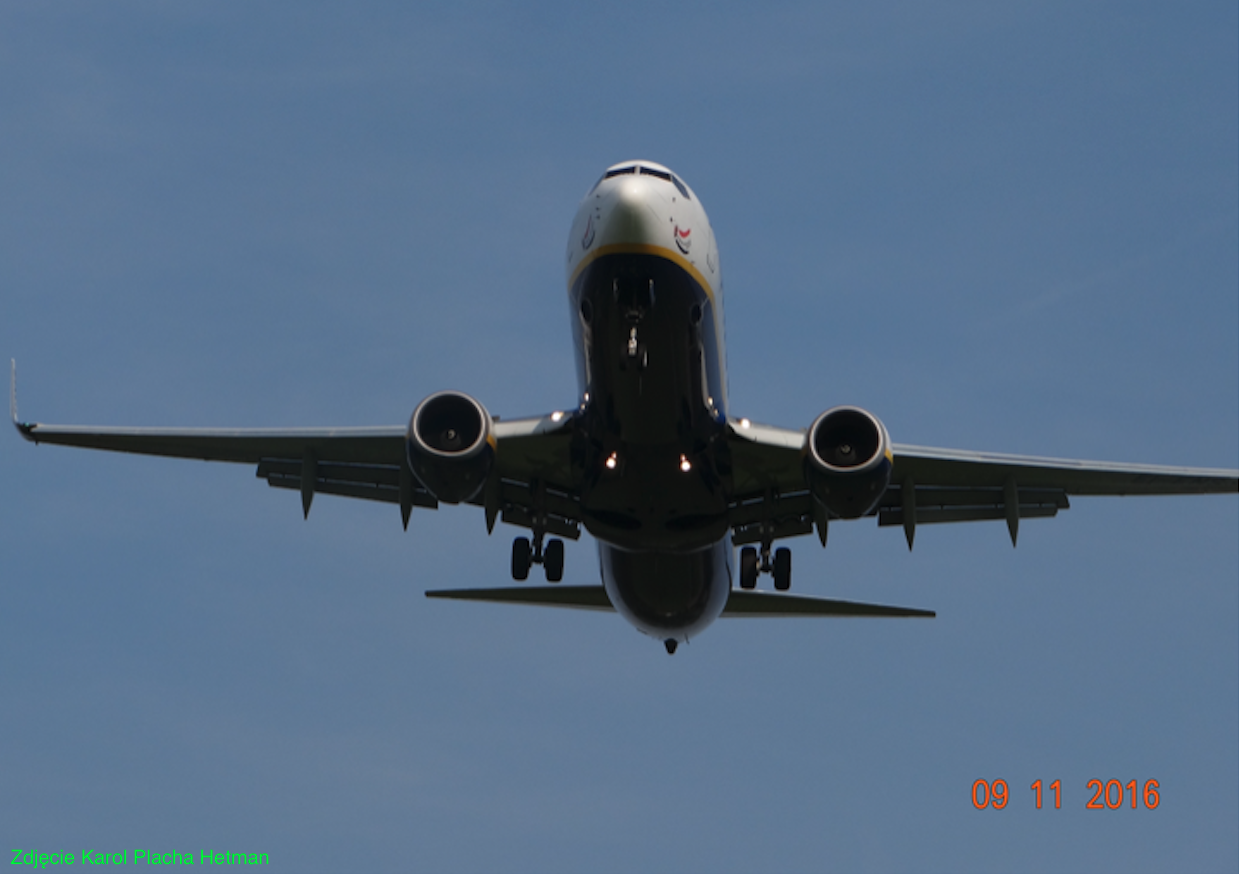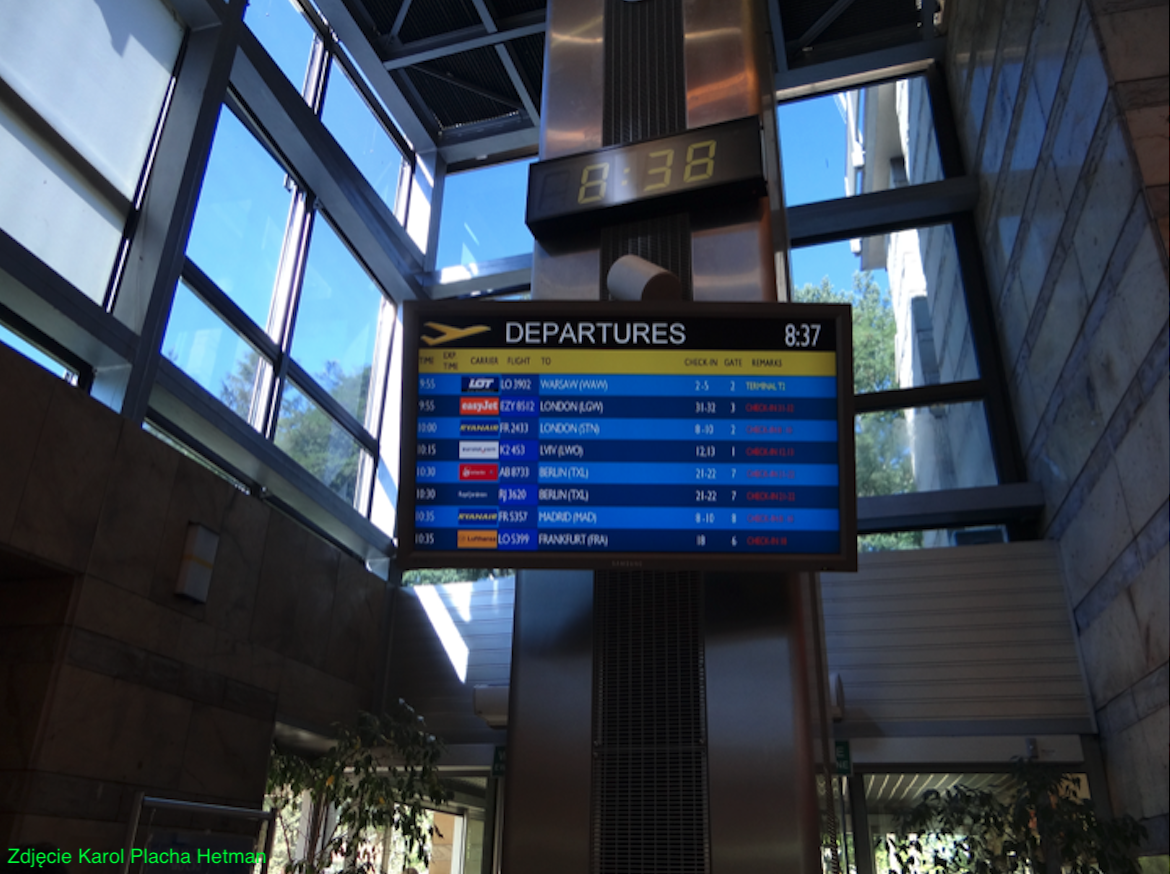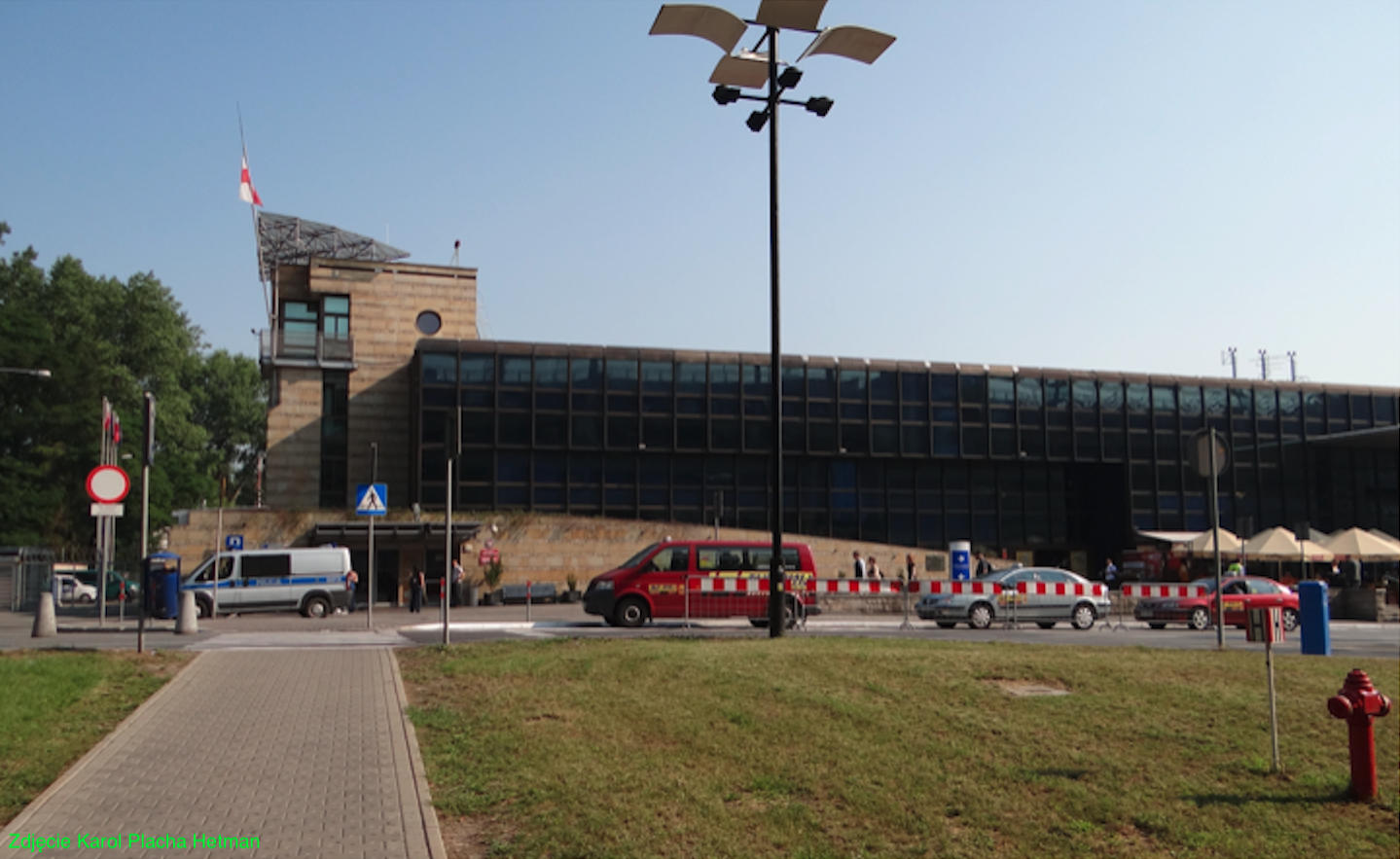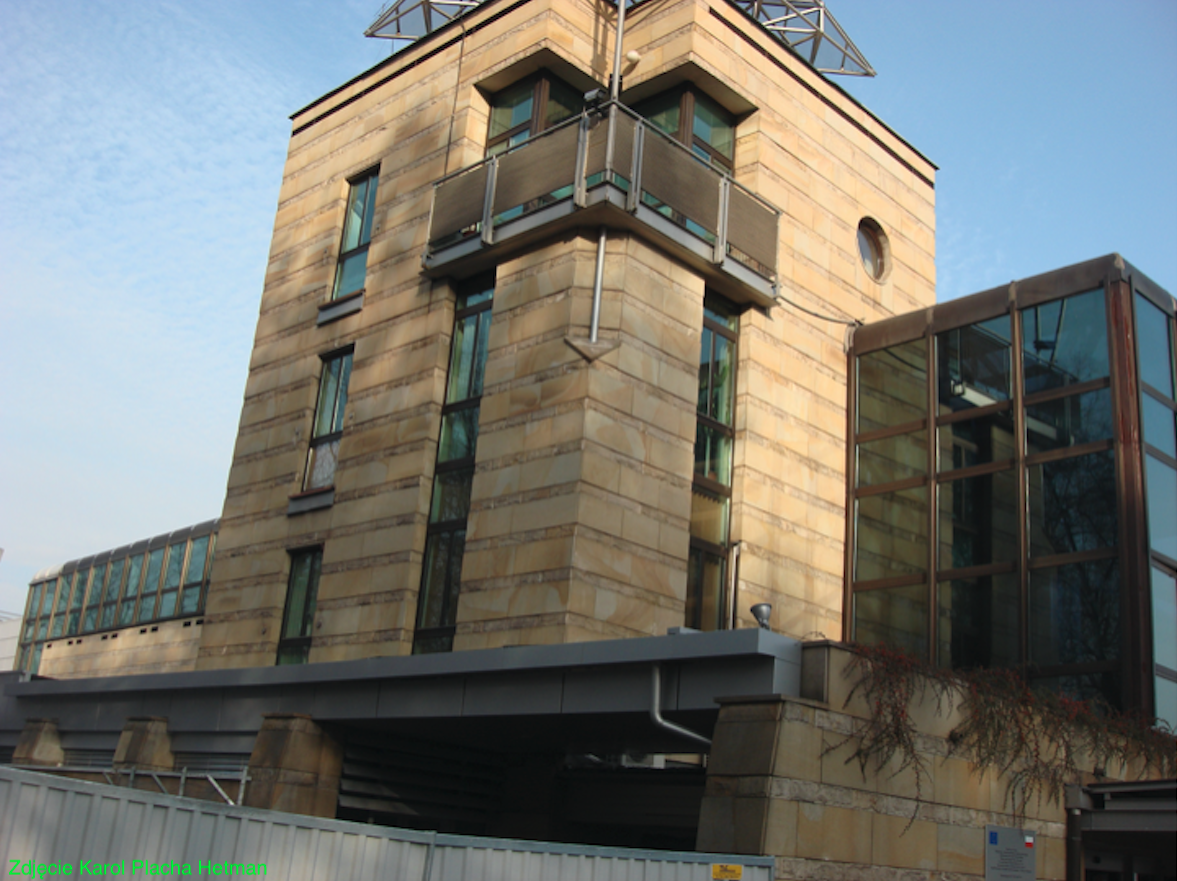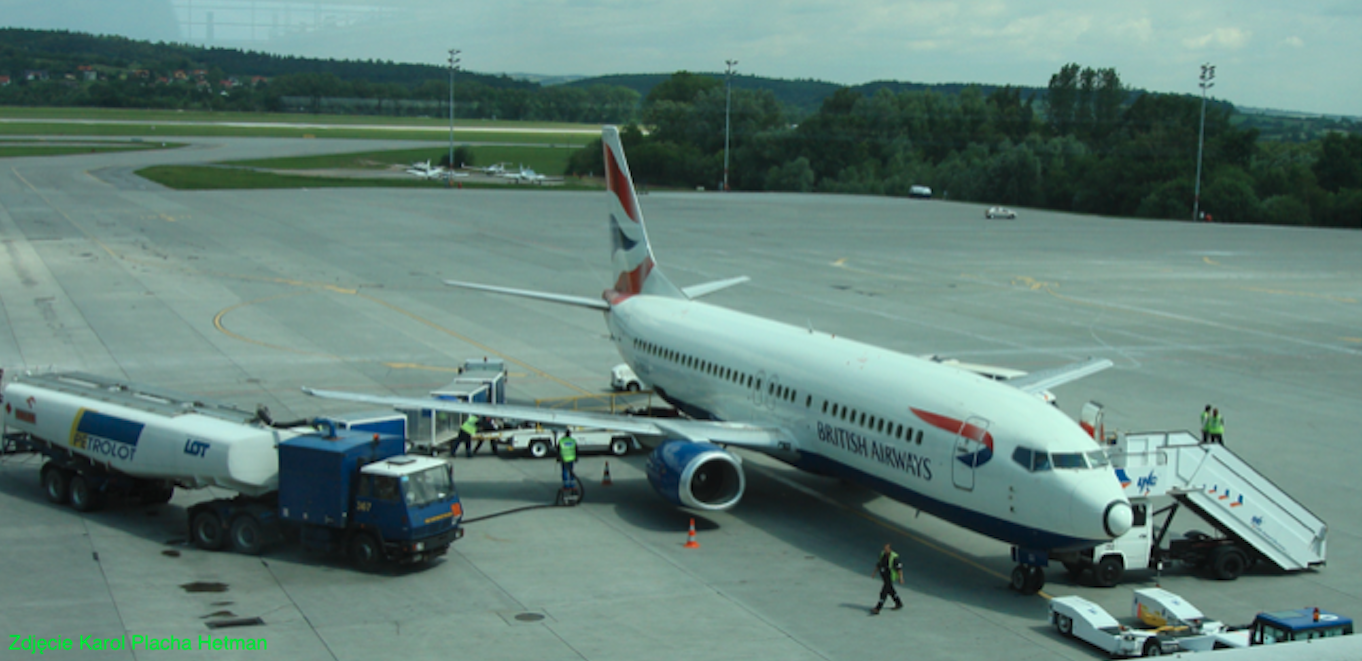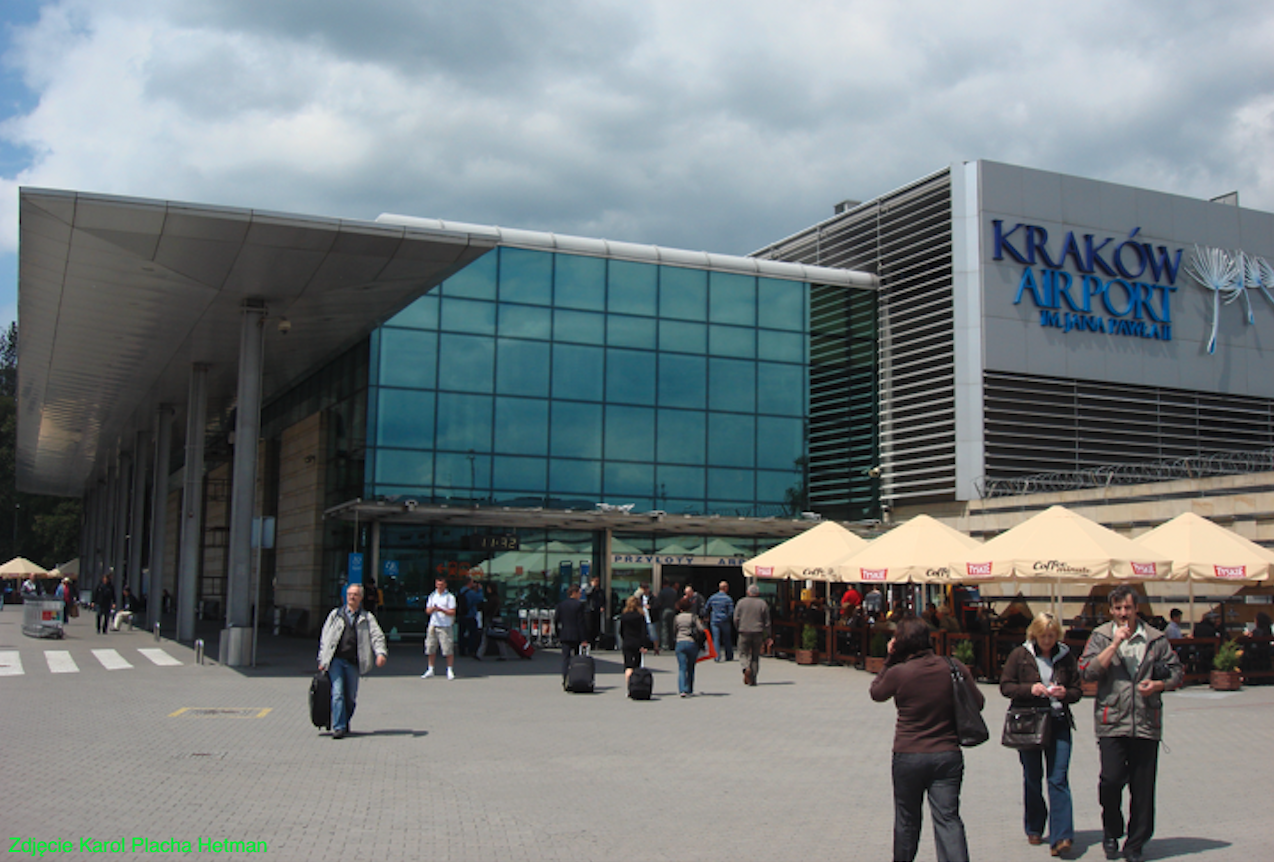Kraków 2012-03-03
Balice Airport.
Geographic coordinates: 50.078N 19.786E. Elevation 241 m.
Further investments. 2009 year.
Kraków Airport has been recording a very high growth rate in the number of passengers served in recent years. In 2007, 3,068,199 passengers were checked in at the port, which made the port once again the runner-up among domestic ports. The development of the airport in Balice now seems to be a foregone conclusion. Until recently, it was assumed that in 2015 the port should receive 3.5 million passengers, and 10 years later – 6.5 million. It is now known that these plans are underestimated, because passenger traffic in Balice is increasing at a much faster rate. There is already a real plan to build it; Terminal 3, a new apron, a new taxiway and a three-star hotel. The installation of sleeves is planned for Terminals. 33.5 hectares of land were acquired for new investments. In 2007, the cost of the Terminal 3 facility was planned to amount to PLN 20 million. PLN 7.5 million was to come from the central budget and PLN 10 million from EU subsidies.
A momentary boost was the possibility of Krakow’s participation in the Euro 2012 event (European Football Championship). Fortunately, there was no mining in Krakow and thanks to this, thousands of tourists and pilgrims did not avoid Krakow.
Comparison of air operations in the years 2003 – 2009: 2003 – 15,086, 2004 – 17,893, 2005 – 26,053, 2006 – 32,490, 2007 – 37,541, 2008 – 35,568, 2009 – 39,876.
Comparison of passenger traffic in the years 1975 – 2009: 1975 – 170,000 people, 1979 – 200,000 people, in the years 1980-1995 the airport served less than 200,000 people, 1996 – 205,000 people, 2000 – 517,015 people, 2001 year – 549,298 people, 2002 – 500,852 people, 2003 – 593,214 people, 2004 – 841,123 people, 2005 – 1,586,130 people, 2006 – 2,367,257 people, 2007 – 3,068,199 people , 2008 – 2,923,961 people, 2009 – 3,234,654 people, 2014 – 3,818,000 people.
In 2009, the following carriers used the Balice airport: Ryanair (30.03%), Easy Jet (21.91%), PLL LOT (10.89%), Lufthansa (10.72%), Norwegian (7.02%). %), Aer Lingus (4.94%), British Airways (2.85%), Transavia, CSA, Brussels Airlines, Austrian Airlines, Jet2, Air Nostrum, Finnair, SAS, Air Berlin, Centralwings and others.
In 2009, Kraków-Balice Airport maintained connections with 57 airports in the world. The most frequent flights were to: Dublin (10.7%), London STN (9.7%), Munich (7.5%), London LGW (7.5%), Warsaw (7.4%), Liverpool (5 .5%), Frankfurt (5.0%), Paris (4.2%), London LTN (4.0%).
Pope Saint John Paul II.
Without a doubt, the most important passenger at the Balice airport was the greatest of all Poles, Saint John Paul II, previously Cardinal Karol Wojtyła, who visited Balice many times. As John Paul II during his first pilgrimage. On June 10, 1979, he flew to Rome on board the Tu-134 SP-LHD plane. The second pilgrimage, on June 23, 1983, departed to Rome on board the Il-62 M SP-LBA. The third pilgrimage, on June 11, 1987, departure to Szczecin. The sixth pilgrimage, on June 10, 1997, departure to Rome. The seventh pilgrimage, on June 17, 1999, departure to Rome. Eighth pilgrimage, on August 16, 2002, arrival from Rome, August 19, 2002, departure to Rome, on board a Boeing 767 SP-LLB. In addition, we will add that John Paul II flew in Poland on board aircraft; Yak-40, Mi-8.
Pope Benedict XVI.
The Holy Father Benedict XVI visited the Republic of Poland once. On May 28, 2006, he flew to Rome on board a Boeing B-767 aircraft.
Unusual planes.
In 1966, the plane that brought French President Charles de Gaulle to Krakow caused quite a sensation. It was, of course, the French plane Sud-Est Caravelle.On April 29, 1998, an El Al Boeing 747 landed at the airport for the first time. It then became clear that the airport could accept this type of aircraft. Although not fully loaded because the DS is too short for their run-up. Boeing 747 planes from Indian, Chinese and other airlines have already landed at the airport.
On May 31, 2003, a Boeing 747 Air Force One landed at the airport.
E-3 A aircraft of the AWACS system. On Thursday, May 7, 2009, on the parking area of the military Balice Airport, a presentation of the E-3 A early warning and control aircraft took place. This unusual opportunity attracted both soldiers and military employees of the Kraków-Balice garrison, as well as a large group of employees of the Kraków International Airport – Balice and representatives of aviation associations. Show participants had the opportunity to board the E-3 A and talk to the aircraft’s crew. The show was scheduled from 10 a.m. to 11 a.m., but due to great interest, it was extended until 11;45.
Air station. 1966 year.
The lack of an airport building (terminal) was bothering everyone in Balice. The design of the new station was developed by the Municipal Design Office in Krakow under the leadership of engineer Adam Kaczor in 1964, according to the design of architect-engineer Andrzej Kurkiewicz. The contractor of the facility was the W. I. Lenin Industrial Construction Company.
When designing the airport station, Swedish models were used. The building was designed on a square plan with sides of approximately 30 m, as a single-story building. In the center there is a small (4 m x 4 m) free space made of glass walls. Its function is to provide daylight to the interior of the facility. In Polish conditions, this was an impractical solution, significantly increasing the costs of heating the facility, and weeds grew inside. The building’s usable area is 905 square meters. The facility was richly glazed with windows with aluminum frames. The front of the building is equipped with two aluminum doors, between which an abstract mosaic is placed on the wall. Such a socialist realist vision, which was still better than red stars or a hammer and sickle. The front of the facade looked similar from the platform slab side. The interior of the facility is divided into domestic and foreign parts. Already in the early 1970s, metal detection gates were used in the security control system.
A road loop was built in front of the building (because it was a road with no crossing), in the form of a safety pin, and inside it there was a parking lot for 50 passenger cars and several coaches. There was also a starting and ending stop for city buses no. 208 from Kleparz and no. 209 from Salwator, operated by MPK (Miejskie Przedsiębiorstwo Komunikacyjne). The station officially opened on September 10, 1966.
The first official foreign visit to Krakow was made on September 16, 1966, by the Shah of Iran, Mohammed Reza Pahlavi, and his wife, who used the airport, which had not yet been officially opened. In September 1967, French President Charles de Gaulle visited Poland, where he was enthusiastically welcomed. During his visit, the president emphasized, among other things, the Polishness of the Recovered Territories. Charles de Gaulle visited Warsaw, Tricity, Kraków, and departed from Balice Airport on board a Sud Aviation Caravelle plane.
New investments. 1969 year.
In 1969, the VASIS (Visual Approach Slope Indicator System) glide angle indicator was installed at Balice Airport, the then PAPI light system.
In 1971, another renovation of the take-off field was carried out, combined with a major modernization. The work was financed both from the military budget and the civil airport authority. The most important element was the extension of the DS (RWY) by 400 m. About 200 m on each side, due to terrain restrictions. The modernized DS has a total length of 2,400 m. Calvert-type approach lights were installed on the main approach 25 (26, 257 degrees). A simplified lighting system was installed on approach 07 (08). Each lamp was placed on an individual wooden pole, identical to the poles used at that time for electric and telephone cables. Along the DS, edge lights have been placed on the roadsides. The same lights appeared on taxiways and PPS.
This does not mean, however, that there was no illumination up to this point. Since the airport was still military, the Łucz lighting system was developed there. Due to the renovation of the SD (RWY), it was closed from May 1971 to October 1971. This does not mean, however, that no planes used Balice Airport. There was a ground DS located parallel to the main road in the northern part of the airport. This road was used by the army and air ambulance. Taxiways were also modernized and expanded. A significant improvement in safety was brought about by the modernized NDB blind landing systems and the PAR system radar station.Zmodernizowana DS (RWY) umożliwiła starty samolotów Ił-18 PLL LOT z kompletem pasażerów i zatankowanych maksymalnie. Dzięki temu bez międzylądowania mogły osiągnąć Moskwę lub Mediolan (zasięg 1 400 km).
An ambulance station and a citizens’ militia station were located near the airport.
Airport Fire Department. 1971 year.
At the same time, the civilian airport was enriched with an airport fire brigade. This was dictated by international regulations. In Balice, they were not particularly concerned about it, because there was a fire brigade unit in the area of the military unit of JW 1616, so there was security on that side. However, at the turn of the 1960s and 1970s, international civil regulations in this area were already very strict. The STAR fire trucks used by the army did not meet these requirements. Both in terms of driving speed and the amount of extinguishing agents taken. The plans for the civilian guard station were approved in 1969, but there were major problems in implementing the facility. Only the intervention of the Ministry of Communication allowed the investment to be finalized, which was put into operation on November 30, 1971. It was a relatively modest facility, located behind the used barracks, on the eastern side. However, the most important were combat vehicles, purchased for foreign currency in the West. The first one was two-axle and did not differ in appearance from those currently used and was delivered in 1978. They replaced Polish JELCZ fire trucks.
Balice in the 70s.
Since 1972, Krakow has gained national connections with other Polish cities. In 1973, connections included; Gdańsk, Bydgoszcz, Koszalin, Szczecin, Poznań and Wrocław and abroad with Varna, Budapest, Konstancja and Burgas. In 1975, Balice Airport served over 170,000 passengers. In 1979, there were already over 200,000 passengers. The main type of aircraft used by LOT Polish Airlines at that time were An-24 turboprops.
In the 1970s, the German company Lufthansa tried to launch a permanent connection with Krakow. However, it turned out to be unprofitable and was liquidated. The American company Pan Am was more fortunate, opening its office in Krakow, at the Main Market Square, offering flights beyond Wielka Woda, from Balice itself, also using planes of other airlines.
The airport station was already overcrowded and needed expansion. Fortunately for the communists, on December 13, 1981, General Wojciech Jaruzelski declared war on the Polish Nation in the form of martial law, and therefore the station did not need to be expanded. Passenger transport dropped to almost zero. There were few flights. In addition to a ticket and a mandatory ID card, each passenger had to have a special pass confirming that they could use this means of transport. On board the plane there were ZOMO members armed with long weapons (ZOMO – militarized citizen militia units), who were constantly watching the passengers.
It is worth mentioning that in the 1970s, plans for the expansion of the airport were not entirely clear. However, they were stopped by another even less realistic project, which was the construction of a new airport for Krakow and Upper Silesia in the town of Balin (between Trzebinia and Jaworzno). It was a bad location in every respect; mining damage, land required expropriation, high costs of building the airport from scratch. At that time, the Mierzęcice Airport, where the 39th PLM was stationed, and which has been known as the Pyrzowice Airport since the beginning of the 90s, was not taken into account.
In a new reality. 1989 year.
The incompetence of the party-communist authorities led to a deepening economic recession. This did not have a positive impact on the development of passenger traffic, not only in Balice. The opening in 1980 of a fast railway connection between Krakow and Warsaw was also a big blow for Balice. The express, traveling along the so-called Central Coal Line, covered this distance in 2 hours and 30 minutes. On this route, the plane began to lose to the train. It is true that the flight took 45-55 minutes, but you had to add the journey to the airport, and you had to be there 60 minutes before departure. Let’s also take into account the limited weight of luggage, not to mention the ticket price. And we won’t take a walk on the plane, we won’t go to WARS and we won’t open the window.
The period of the 1980s was a time of sham economic activities carried out by communists, who were already preparing to change into liberals and freemasons, and, above all, took ownership of state property. The Air Traffic and Communication Airports Authority was transformed into the National Airports Enterprise on October 23, 1987, abbreviated as PPL (Airports Enterprise). The new company took over the property and became independent from generally understood state ownership and control.
1989 year.
On May 24, 1989, at the Balice Airport, the second part of the ceremony took place, giving the PLL LOT Boeing B 767-200 aircraft the registration SP-LOB, the name Kraków (as the second capital of the Republic of Poland, the first Gniezno – SP-LOA, the third Warsaw – SP -LOC B 767-300). The godmother of the machine was the Krakow sportswoman, Olympian and gymnast, Teresa Folga. The first part of the ceremony took place at the factory in Everent, USA, in the presence of the Polish diaspora from the USA.
New terminal.
On April 19, 1988, the first agreement was concluded between the city of Kraków and PPL. It concerned taking joint action aimed at building a new passenger station (terminal) for foreign traffic. A year later, on June 26, 1989, both entities signed an agreement on the joint construction of a new terminal. (We have already adopted the Western terminology; terminal, not airport). The cost share of the program was as follows; 25% city of Kraków, 75% PPL.
The new terminal was located on the western side of the old station. At its base it was slightly larger than the old station, but in terms of volume it was more than four times larger. Its volume was 15,200 m3 and the usable area was 2,400 m2. The terminal is designed to handle 280,000 passengers/year. These estimates were extremely low. Let us recall that already in 1979, Balice Airport served over 204,000 passengers. Therefore, it was decided that the new terminal would be the first stage. The second stage was to be an extension on the site of the old airport station. The target volume is 31,740 m3 and the usable area is 4,400 m2. This facility was supposed to serve 450,000 – 500,000 passengers. Construction of the new terminal began in the fall of 1989. The first stage of construction of the new terminal was completed in January 1993.
The terminal was really nice. From the side of the access road, its corner was very representative. The corner was designed as a four-story tower with a sandstone façade. The main building was made as a simple cube, with a façade richly glazed with smoked glass. The small remaining fragments of the walls were covered with sandstone. There were two wide entrances with glass automatic doors leading to the terminal. There was a main hall and a mezzanine in the terminal. The main hall houses ticket and baggage check-in points, ticket offices of various carriers and waiting areas. The security control zone is located in a generally inaccessible area. On the mezzanine there are shops, bars, toilets and the Roman Catholic Chapel. There were two exits from the mezzanine to an open observation deck, open only during aircraft arrivals and departures. The terrace was about 40 meters long and about 6 meters wide. The building had a basement used by airport services.
On November 30, 1995, the expanded terminal was officially opened. Its usable area was nearly 5,000 m2. The terminal provided a capacity of 450,000 – 500,000 passengers/year.
1992 year.
In 1992, the idea of transforming Balice Airport into a joint-stock company was born. This was related to the transformations carried out in PPL (Państwowe Przedsiębiorstwo Porty Lotnicze) and the enfranchisement of the old nomenclature. In Krakow, the problem was very complex. The Polish Army had no intention of leaving Balice. But the drastic reduction in the number of soldiers resulted in a reduction in guard service and the protected area. In addition, the previous owners claimed their land. The 50-year-old fence, which was dilapidated and had holes in it, required renovation. The farm gates were unsecured and practically open. Wild boars and deer were walking around the flight field, posing a threat.
At the south-eastern end of the airport there was a car exchange, which moved here from Imbramowski Square in Krakow. The stock exchange was very popular among the inhabitants of Małopolska and Upper Silesia, but was strongly condemned by the new-old authorities. Officially it was said that the stock exchange was causing traffic jams and passengers were late for their planes. In fact, they wanted to take over the land from the owners for a low price. The stock exchange finally disappeared in 2002, and moved to the metallurgical plant in Nowa Huta and to Plac na Rybitwach. In the period 2002-2004, a car exchange operated on adjacent private fields, which was not accepted by the authorities and was vigorously fought against. The problem was finally solved in 2004 by the District Construction Supervision Inspectorate, imposing huge fines on the land owners.
On the subject of land, it must be said that; in 1996, the airport company owned approximately 24 hectares of land. It was not possible to acquire the areas to the west used by the 8th Air Base. However, it was realistic to obtain an area towards the east, approximately 35 hectares, where, among other things, a car exchange was organized. This area was under the responsibility of AMW. Therefore, the further development of the Balice Port depended on the acquisition of land managed by the Military Property Agency. The problem, however, was that AMW wanted to sell them, not give them away for free. And media pressure and visits from high government officials did not help. The law on this topic was consistent and clear. Local governments wanted plots of land from the army for free throughout Poland, and the law prohibits such a solution. So let’s not be surprised that in 2008, the Government of Prime Minister Donald Tusk took steps to liquidate AMW, which only proves the incompetence of this Government, which was unable to navigate the existing law. Nay. AMW has already consented to the construction of new facilities in these areas. Importantly, these areas could have been sold without a tender if they were important social purposes, and this was the case here. The only question left was the price and discount. This means that the development of Balice Airport was not at risk, and it is only about correct settlements.
As a result of many years of talks, the concept of a limited liability company was born. They were to become its shareholders; PPL, Commune of Kraków (Voivode of Krakow), Commune of Zabierzów, State Treasury. The case was finalized on July 5, 1996, a private limited liability company was established by notarial deed under the name; "Kraków-Balice International Airport." based in Balice. The company took over the fixed assets contributed by the partners in the form of material contributions.
1995 year.
In 1995, the platform slab was still from the 1970s, when it was enlarged. It had dimensions of 215 m x 65 m. It allowed only three Tu-154 or two B 767 planes to park at the same time. In addition, the planes had to position themselves diagonally. Pushback vehicles were not used in Balice at that time. There were only airport tractors (not to be confused with tractors, agricultural tractors). The condition of the platform slab was poor. Renovation was carried out (1995) by applying another layer of concrete. The final renovation of this part of the platform slab was carried out only in the spring of 2014. Partial renovations of the taxiway were also carried out in places where the surface was very crumbly.
In 1996, the platform was significantly enlarged towards the east. The shape of the platform slab was irregular because the trees in that area and the sewage and rainwater treatment plant operating there had been preserved. The area of the platform slab increased by over 200%. Thanks to this, 7 code C planes and one code D plane could park at PPS.
Photo description: On the platform there is a Boeing B-737-400 aircraft, registration G-DOCU, British Airways. Aircraft MSN 25854, No. 2417. Aircraft delivered in 1993 and scrapped in 2015.
At the same time, an additional exit was made from the taxiway to the platform. Looking from the PPS side, left exit. The condition of DS (RWY) was also not the best. We managed to obtain funds not only for renovation, but also for extending it by another 150 m, to 2,550 m. This increased the level of safety. Importantly, the threshold and sight remained in the same places. A new lighting system was installed in the surface. The entire DS (RWY) received new edge lighting. The lighting on the approaches was also replaced with a new type, suspended on easily breakable metal posts. During these renovations (April 1, 1995 – December 1, 1995), Balice Airport served only medical and small military and private planes. Takeoffs and landings were performed on a part of the taxiway. The designated RWY had dimensions of 1,200 m x 23 m.
In the mid-1990s, the first ILS landing support system, category I, was installed at Balice Airport.
Practically, the new DS (RWY) could accommodate all aircraft in the world, including Concorde, B 747, C-5. Although these giants could only operate with a limited load.
At that time, Balice Airport was named John Paul II International Airport. Okęcie Airport also competed for this honorable name, but the strong ties of the Greatest of Poles with Krakow meant that this honor went to Balice Airport.
1996 year.
Balice Airport received a modern meteorological station that cooperated with the Institute of Meteorology and Water Management. The new station received an automatic system warning against possible icing and rapidly appearing fog. Let us recall that at the turn of the 1950s and 1960s, party activists of the Polish United Workers’ Party expressed the opinion that fog was a rare phenomenon in Balice. Unfortunately, life quickly verified this opinion. Balice has big problems with fog, especially in October and November. Many flights are redirected to Pyrzowice, Okęcie or Rzeszów Airports, which makes further travel difficult for passengers.
Another element improving safety was the commissioning of a GEC Marconi radar station.
It was only in 1996 that Balice Airport broke the record of checked-in passengers from 1979. Over 205,000 passengers. This proves the huge collapse that the communists caused in Poland in the 1980s.
1997 year.
On March 18, 1997, the owner of the civil Balice Airport, a limited liability company, obtained from the Department of Civil Aviation of the Ministry of Transport and Maritime Economy a license to conduct business activities in the civilian part of the airport, and then the required certification. On July 1, 1997, the Kraków – Balice International Airport Company started its operational activities, taking over all employees of P.P. "Airports" and taking over their management. The company with its registered office in Balice, 32-083 Balice ul. Capt. M. Medweckiego 1, is a commercial law company with a share capital of PLN 101,232,000, entered into the register of entrepreneurs kept by the District Court for Kraków – Śródmieście in Kraków, 11th Commercial Division of the National Court Register under the KRS number 0000008522. In a formal sense, the airport is still a facility shared by the military and the civilian side.
Changes in Poland and breaking away from the influence of CCCP resulted in more and more tourists, entrepreneurs and pilgrims coming to Krakow. A large percentage of them arrived in Krakow by air. Balice Airport began to accept more and more passengers. In 1995, the first Western airlines appeared in Balice; Swissair, Crossair, Austrian Airlines. In 1997, British Airways opened connections. Also in 1997, several charter flights from the USA were operated by ATA using Lockheed L-1011 aircraft. At the end of 1997, LOT Polish Airlines opened a permanent connection from Balice to New York and Chicago, using B 767 aircraft. The connections were very popular and profitable, but a few years later, despite the opposition of the inhabitants of Małopolska, LOT Polish Airlines closed them.
In 2003, the most famous plane in the world, B 747 Air Force Ona, with President George W. Bush landed at Balice Airport.
1998 year.
On July 23, 1998, by resolution of the Shareholders’ Meeting, the Company adopted the name International Airport. Jana Pawła II Kraków – Balice Sp. z o. o., i.e. manages the civil part of the airport. The total area of the airport is 426 ha, including the area managed by the International Airport. Jana Pawła II Kraków – Balice Sp. z o. o. are approximately 24 ha. The purpose of the Company’s activities was; expansion, modernization and operation of the Krakow International Airport and undertaking all activities related to the handling of air passenger and cargo traffic, including the international border crossing at the airport, in order to promote Krakow and the region, improve tourist traffic, and more generally, perform tasks related to public utility. In accordance with the Act of March 8, 1990, on municipal self-government.
1999 year.
On June 17, 1999, Pope John Paul II consecrated the cornerstone and signed the foundation act for the expansion of the airport.
2001 year.
The terminal was put into operation in 1995 and was expanded until 2001. The expansion consisted of adding another hall in place of the first station. The investment cost PLN 38.8 million.
Over time, the terminal turned out to be too small. In the technical part, one of the halls was adapted as Terminal No. 2 to handle domestic flights. Thanks to these activities, Balice Airport was able to serve up to 3,500,000 passengers per year. In 2014, the next stage of expansion of the main terminal began.
Written by Karol Placha Hetman

